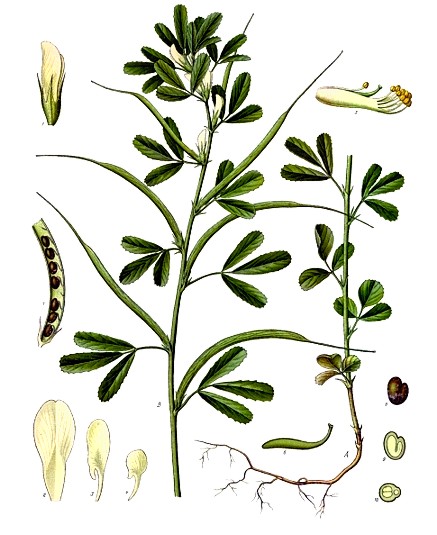Lessico
Fieno
greco
Trigonella fenum-graecum

In latino il sostantivo neutro della seconda declinazione che identifica il fieno viene scritto in modi diversi: fenum, faenum, foenum. La forma più corretta parrebbe essere faenum. Ma non tutte le fonti concordano, anzi, talune danno come corretta la grafia foenum facendolo derivare dal celtico foen. Dal punto di vista vocale è la stessa cosa, in quanto i tre vocaboli si pronunciano allo stesso modo.
Attenzione: anche se l'etimologia è comune (in parole povere = raccolto) il sostantivo neutro fenus o faenus, genitivo fenoris, significa interesse di un capitale, usura, debito, ma anche frutto. E gli antichi Latini scrivevano il fieno greco in almeno 3 modi diversi: faenum Graecum, faenograecum, faenugraecum.
Trigonella fenum-graecum: erba perenne della famiglia Papilionacee o Fabacee, originaria dell'Asia occidentale e introdotta in Europa fin dall'antichità. Ha foglie trifogliate e fiori solitari o a coppie, giallastri; i frutti sono legumi lunghi ca. 10 cm, che contengono fino a una ventina di semi gialli, di odore penetrante e sapore sgradevole, ricchi di mucillagine, proteine e con una piccola quantità di alcaloidi (trigonellina e colina). La pianta è coltivata per sovescio o per foraggio; i semi vengono usati come succedaneo del caffè e per emollienti ed eupeptici in veterinaria.

Fenugreek (Trigonella fenum-graecum) belongs to the family Fabaceae. Fenugreek is used both as a herb (the leaves) and as a spice (the seed). It is cultivated worldwide as a semi-arid crop. It is frequently used in curry.
The name fenugreek or fenum-graecum is from Latin for "Greek hay". Zohary and Hopf note that it is not yet certain which wild strain of the genus Trigonella gave rise to the domesticated fenugreek but believe it was brought into cultivation in the Near East. Charred fenugreek seeds have been recovered from Tell Halal, Iraq, (radiocarbon dating to 4000 BC) and Bronze Age levels of Lachish, as well as desiccated seeds from the tomb of Tutankhamen. Cato the Elder lists fenugreek with clover and vetch as crops grown to feed cattle (De Agri Cultura, 27).
The rhombic yellow to amber colored fenugreek seed, commonly called Methi, is frequently used in the preparation of pickles, curry powders and pastes, and is often encountered in the cuisine of the Indian subcontinent. The young leaves and sprouts of fenugreek are eaten as greens, and the fresh or dried leaves are used to flavor other dishes. The dried leaves (called kasuri methi) have a bitter taste and a strong characteristic smell.
In India, fenugreek seeds are mixed with yoghurt and used as a conditioner for hair. It is one of the three ingredients of idli and dosa (Tamil). It is also one of the ingredients in the making of khakhra, a type of bread. It is used in injera/taita, a type of bread unique to Ethiopian and Eritrean cuisine. The word for fenugreek in Amharic is abesh, and the seed is reportedly also often used in Ethiopia as a natural herbal medicine in the treatment of diabetes. It is also sometimes used as an ingredient in the production of clarified butter (Amharic: qibé, Ethiopian and Eritrean Tigrinya: tesme), which is similar to Indian ghee. In Turkey, fenugreek gives its name, çemen, to a hot paste used in pastirma. The same paste is used in Egypt for the same purpose. The Arabic word hulba (Helba in Egypt) for the seed resembles its Mandarin Chinese counterpart hu lu ba. In Yemen it is the main condiment and an ingredient added to the national dish called saltah. Fenugreek, or Sambélilé in Persian, is also one of four herbs used for the Iranian recipe Ghormeh Sabzi.
In Egypt, fenugreek seeds are prepared as tea, by being boiled then sweetened. This is a popular winter drink served in coffee shops. In other parts of the Middle East fenugreek is used in a variety of sweet confections. A cake desert known as Helba is served in the Islamic world as a tasty treat during Islamic holidays. This is a semolina cake covered in sugar or maple-like syrup, then sprinkled with fenugreek seeds on top.

Dried fenugreek seed
Fenugreek seeds are a rich source of the polysaccharide galactomannan. They are also a source of saponins such as diosgenin, yamogenin, gitogenin, tigogenin, and neotigogens. Other bioactive constituents of fenugreek include mucilage, volatile oils, and alkaloids such as choline and trigonelline.
A side effect of consuming even small amounts of fenugreek (even as just an infusion in water) is a maple syrup or curry smell in the eater's sweat and urine, which is caused by the potent aroma compound sotolone. Fenugreek is frequently used in the production of flavoring for artificial syrups. The taste of toasted fenugreek is additionally based on substituted pyrazines, as is cumin. By itself, it has a somewhat bitter taste.
Fenugreek is mainly used as a digestive aid. Fenugreek seed is widely used as a galactagogue (milk producing agent) by nursing mothers to increase inadequate breast milk supply. It can be found in capsule form in many health food stores.
Supplements of fenugreek seeds were shown to lower serum cholesterol, triglyceride, and low-density lipoprotein in human patients and experimental models of hypercholesterolemia and hypertriglyceridemia (Basch et al., 2003). Several human intervention trials demonstrated that the antidiabetic effects of fenugreek seeds ameliorate most metabolic symptoms associated with type-1 and type-2 diabetes in both humans and relevant animal models (Basch et al., 2003; Srinivas, 2005). Fenugreek is currently available commercially in encapsulated forms and is being prescribed as dietary supplements for the control of hypercholesterolemia and diabetes by practitioners of complementary and alternative medicine.
In recent research, fenugreek seeds were experimentally shown to protect against cancers of the breast (Amin et al., 2005) and colon (Raju et al., 2006). The hepatoprotective properties of fenugreek seeds have also been reported in experimental models (Raju and Bird, 2006; Kaviarasan et al., 2006; Thirunavukarrasu et al., 2003).